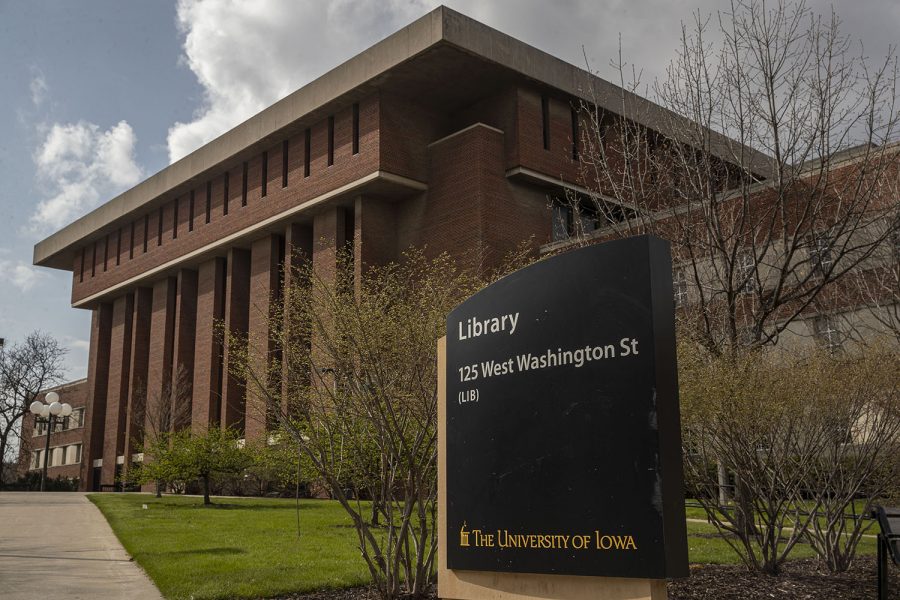‘Sackner Archive’ exhibit brings new meanings to poetry and visual art
The University of Iowa Main Library Gallery recently unveiled their newest exhibit, the Sackner Archive of Concrete and Visual Poetry, a collection of over 75,000 artistic works. The exhibit highlights select pieces that bring new and intriguing meaning to poetry and forms an intersection between literature and visual art.
University of Iowa Main Library is seen on Wednesday, April 15, 2020.
October 13, 2020
Entering the Sackner Archive exhibit, a plethora of literary and visual artistic works are seen encased in glass boxes and hung on every available wall, with colors popping off pages and words arranged in complex and eccentric patterns that draw one in for a unique artistic experience.
The collection of over 75,000 works of concrete and visual poetry has been accumulated by Ruth and Marvin Sackner since 1979. Though both Sackners have now passed, their decades of work is memorialized in the archive.
Originally founded in Miami Beach, Florida, the archive has had a long history of moving locations, but it found a permanent home at the University of Iowa in 2019, according to a press release from the Main Library Gallery.
The Main Library Gallery unveiled the exhibition Sackner Archive in late August, containing a sampling of over 70 selected pieces from the full collection. The exhibit allows students and guests to learn about concrete poetry — a style of poetry where the poem’s meaning is conveyed visually or through pattern — as well the style’s history and the varied ways it can take form. Currently, Sackner Archive can only be visited in person by appointment, but there is an extensive online gallery that showcases and explains many of the exhibit’s pieces.
RELATED: New University of Iowa library collection documents daily life during COVID-19
Main Library Gallery Exhibition and Engagement Coordinator Sara J. Pinkham said that the archive aims to exhibit unique and innovative ways visitors can read poetry, as opposed to traditional left to right linear poetry.
“[The archive] is very eclectic. The Sackners were collectors who had an eye for the unique and the bold, a reverence for early works, and a deep appreciation of living artists and their creative processes,” Pinkham said. “The exhibition itself is an excellent way to become acquainted with both the Sackner collection and to learn about forms of poetry that are perhaps a little more off the beaten path.”
Tim Shipe, the curator of the International Dada Archive and one of three co-curators for the Sackner Archive exhibit, described the process as a team effort to make sure that the UI would be fit to hold the collection.
“My own involvement started in early 2018, when Marvin Sackner was reaching out in search of a permanent home for the collection,” Shipe said. “With several others, I helped to make the case that Iowa was the perfect place to carry on the legacy of the Sackners.”
Shipe went on to describe the collection as a snapshot of the Sackner’s everyday lives. They collected the works, lived among them in their home, studied them, and compiled catalogues. They even sent them on loan to exhibitions around the world before finding the entire archive a permanent home in Iowa.
“But still, this was a private collection in a private household, and the Sackners always envisioned eventually finding a new home in an institution where it could more easily be made accessible to the public,” Shipe said.
RELATED: “Pull of Horses” exhibit uses new tools to tell history of horses in IC
Co-curator of the exhibition, Peter Balestrieri, the Special Collections Curator for science fiction and popular culture collections at the UI Libraries, said the original goal of the Sackners is still carried out through the exhibit.
“The goal of the Sackner Archive was to hold the lifetime of passionate collecting that Marvin and Ruth Sackner did in the fields of concrete and visual poetry. That was and is its primary goal. In accomplishing that goal, it expanded the boundaries of concrete and visual poetry and created a resource for research unique in the world,” Balestrieri wrote in an email to The Daily Iowan.
Balestrieri said the archive can serve as a great inspiration to aspiring authors and artists, both on and off campus.
“It is a testament to the human imagination, and it is an honor and a privilege to host it and to provide access through events like this exhibit,” he said.

















